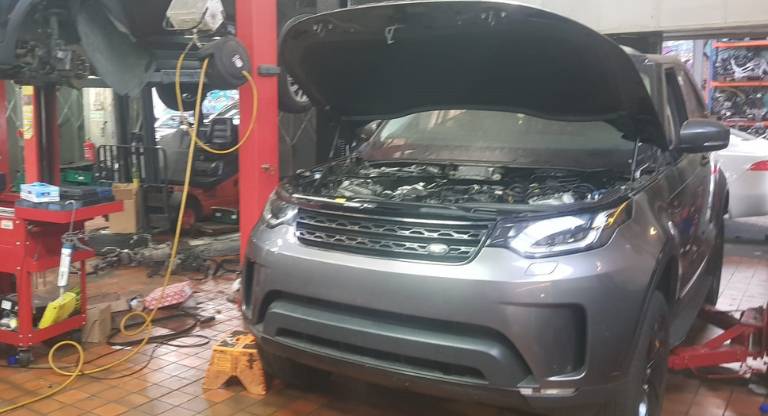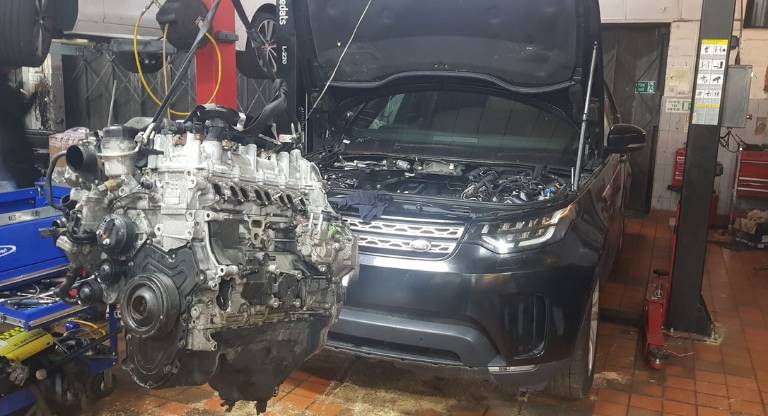- August 27,2025
Land Rover Ingenium Engine Problems You Should Never Ignore
The Ingenium engine family was supposed to take Land Rover into a new era. The units are efficient and modular and have been fitted to models like the Range Rover Evoque, Discovery Sport and Defender. Despite this promise, many owners have found themselves seeking reconditioned Land Rover engines and turning to Land Rover Engine Specialists because of unexpected faults. These modern engines have aluminium blocks and chain‑driven dual overhead camshafts, and they use up to date turbocharging and fuel systems, yet complaints about reliability have mounted. The 2.0‑litre Ingenium diesel was introduced in 2015 as part of a modular engine family with 1.5‑litre three‑cylinder and 3.0‑litre six‑cylinder versions. This flexible design aims to cover different power outputs and meet Euro 6 emissions standards, but problems like early timing chain wear, turbo failures, oil dilution and Diesel Particulate Filter (DPF) issues have tarnished its reputation. This blog explains those problems and why ignoring them can lead to catastrophic engine damage. It also shows how maintenance and specialist help can keep these engines running.
Why do Ingenium engines fail?
When the Ingenium engine debuted, it promised efficient power with low friction. The modular layout uses 500 cc per cylinder, and variations include three‑cylinder, four‑cylinder and six‑cylinder versions. The block and head are made from aluminium, with cast‑iron liners, variable valve timing and chain drive cams. But the 2.0‑litre diesel quickly attracted complaints. Many owners reported catastrophic failures at around 50000 miles. These failures often start with components designed to last the lifetime of the engine, but which wear prematurely. Short service intervals recommended by some UK specialists have also revealed that long factory intervals may allow problems to build up.
Timing chain trouble

One of the most common Ingenium engine problems is timing chain failure. The timing chain synchronises the crankshaft and camshaft and keeps pistons and valves moving in harmony. On the Ingenium engines, plastic chain guides can wear quickly. When the guides degrade, the chain stretches or slips. A stretched chain can cause mis‑timing, knocking noises, and in the worst cases, the chain can snap. If the chain fails, valves and pistons collide, and the engine seizes. Replacement is expensive: an early‑detected chain problem may cost £1500 – £3000, but if the stretched chain causes wider damage, a full engine rebuild can exceed £20000 in the worst case. Engines built after 2019 have improved chains, but owners of earlier vehicles should have the chain checked regularly and not rely on factory service intervals.
Turbocharger and injector failures
Another serious Ingenium problem involves the turbocharger. Turbos boost power by forcing more air into the engine, but they rely on clean oil and good lubrication. Reports show that oil leaks or blockages can cause the turbo to overheat and fail. When a turbo fails, oil or coolant can leak into the cylinders and cause hydrolock – a condition where pistons attempt to compress liquid and bend connecting rods. Owners have reported turbo failures as low as 50,000 miles. Replacing a turbo can cost £ 4,000 – £ 6,000, and if the failure damages other components, the cost climbs toward a full rebuild. Fuel injector issues are less common but equally serious. Some drivers have noticed that malfunctioning injectors over‑fuel the combustion chamber, creating excessive heat that can melt pistons or crack cylinder liners. These injector failures can cost £1500 – £3000, but severe damage again leads to a rebuild.
Oil dilution: a hidden killer
Oil dilution is arguably the most frustrating Ingenium fault. Owners of 2.0‑litre diesel models often see the “Service Required” message long before the promised 21,000-mile interval. Independent JLR specialists have traced the cause to the DPF regeneration process. When the DPF becomes clogged, the engine injects extra fuel to burn off soot. During short trips, the regeneration cycle is interrupted, so unburnt fuel drips past piston rings into the oil sump. This fuel dilution reduces the oil’s viscosity and compromises lubrication. Because of oil dilution, many independent specialists recommend changing oil every 7,500 – 10,000 miles rather than following longer intervals.
DPF regeneration and placement problems
The Diesel Particulate Filter is essential for meeting Euro 6 emissions, but its design in certain Land Rover models contributes to many problems. On some vehicles, the DPF is mounted further from the turbo, which keeps it cooler. This placement makes it harder for the filter to reach the required 800 °C for regeneration. As a result, regeneration cycles fail to complete, more fuel is injected in repeated attempts, unburnt fuel dilutes the oil and turbochargers suffer from poor lubrication. Owners who drive mainly short distances are especially at risk. To mitigate problems, it is important to use the vehicle on longer drives to allow the DPF to regenerate and to monitor the oil level regularly. If oil dilution is detected, early oil changes and updated software or hardware from specialists can help.
Should you ignore these problems?

Ignoring Ingenium engine problems is expensive. Timing‑chain failures can destroy an engine; turbocharger failures can cause hydrolock; oil dilution can damage bearings and lead to catastrophic wear. Independent specialists stress that regular maintenance and shorter service intervals are essential. Using a Land Rover Engine Specialist who understands these engines and can offer updated components or software is sensible. For example, improved timing‑chain kits and updated turbo oil feed pipes are available. Keeping the DPF system functioning by taking occasional longer trips also helps. When major damage occurs, fitting a reconditioned Land Rover engine from a trusted rebuilder can save money and extend the vehicle’s life. These rebuilt units have often had weak points addressed and come with a warranty, making them a practical alternative to scrapping the vehicle.
Frequently Asked Questions
How much does it cost to replace the engine in a Land Rover?
Replacement costs vary with engine type and labour rates. In the UK, labour typically takes 15–25 hours at £60–£100 per hour, so labour alone can cost £900–£2,500. A reconditioned engine costs about £2,500–£4,500, a used engine £3,000–£5,000 and a new OEM engine about £4,000–£6,000. Altogether, replacing an engine may cost £5,000–£10,000 or more depending on additional parts and damage.
How long do Land Rover engines last?
With regular servicing and sensible driving, a modern Land Rover engine should last 150,000–200,000 miles, or around 10–15 years. Older engines like the 200Tdi can deliver 200,000 miles or more when properly maintained. The Ingenium 2.0‑litre diesel has shown premature failures, so reduced service intervals and attentive maintenance are essential.
What is the best or most reliable Land Rover engine to buy?
Many enthusiasts consider the 200Tdi and 300Tdi diesels to be the most reliable because of their mechanical simplicity and ease of maintenance. For newer vehicles, the 3.0‑litre Ingenium six‑cylinder petrol (P400) or diesel (D300) engines are smoother and less troublesome than the earlier 2.0‑litre units. Avoid engines with known timing chain problems and look for full service history.
Which Land Rover engine should I avoid?
The 2.0‑litre Ingenium diesel has gained notoriety for timing chain failures, turbocharger issues and oil dilution. Cars using these engines may fail at 50,000 miles or less. Unless thoroughly serviced and updated, they can be costly to repair.
Are Land Rover diesel engines reliable?
Older diesels (200Tdi, 300Tdi and the 3.0‑litre TDV6/SDV6) have good reputations for reliability when maintained. The 2.0‑litre Ingenium diesel is problematic, but the newer 3.0‑litre D250 and D300 inline‑six diesels are smoother and more robust thanks to updated timing chains and better oil control. Diesel engines still offer strong torque and fuel efficiency, but they need frequent oil changes and periodic DPF cleaning to remain healthy.
Does Land Rover use BMW engines?
Yes. Land Rover adopted BMW’s 4.4‑litre twin‑turbo V8 (known internally as the N63) for the latest Range Rover and Range Rover Sport models. This P530 engine produces 523 hp and 750 Nm of torque, replacing Land Rover’s in‑house 5.0‑litre supercharged V8 because it offers better efficiency.
Does Land Rover use Ford engines?
Land Rover previously used Ford’s DuraTorq diesels and EcoBoost petrol engines. For example, early Discovery Sport models (2015) used Ford 2.0‑litre EcoBoost petrol and 2.2‑litre Duratorq diesels. The Defender was fitted with Ford’s 2.4‑litre DuraTorq “Puma” engine when it replaced the Td5 in 2007. These engines have been phased out as JLR has moved to the Ingenium family.
Which Land Rovers have the Ingenium engine?
Since 2015, the Ingenium engines have powered a wide range of Land Rover models, including the Discovery Sport, Range Rover Evoque, Velar, Range Rover Sport (P360 and P400), full‑size Range Rover (P360, P400 and P550e plug‑in hybrid), Defender (P300 and P400), and fifth‑generation Discovery. The engines are offered in 2.0‑litre four‑cylinder petrol and diesel versions, 3.0‑litre inline‑six petrol and diesel versions with mild‑hybrid technology and 1.5‑litre three‑cylinder plug‑in hybrids.
Is the Land Rover Ingenium engine reliable?
The Ingenium engine family has improved over time, but early 2.0‑litre diesel units suffered timing chain and turbo failures and oil dilution issues. Later revisions and the move to six‑cylinder engines addressed some of these problems. Reliability is better when oil is changed more frequently and the timing chain and turbo feeds are inspected regularly. For owners concerned about long‑term dependability, choosing a petrol Ingenium or the newer 3.0‑litre mild‑hybrid variants and maintaining shorter service intervals can offer greater peace of mind.
When did Land Rover stop using the Ingenium engine?
Land Rover has not stopped using the Ingenium engine. The modular family remains the backbone of its model range in 2025, though high‑end models now use BMW’s V8, and future vehicles will transition to electric power. There is no official date when Ingenium production will cease.
What engine is in the Land Rover Defender (classic and new)?
Classic Defender models (up to 2016) used several engines over the years: early versions had 2.25‑litre petrol and diesel four‑cylinders, which were replaced by the durable 200Tdi and 300Tdi 2.5‑litre diesels. The TD5, introduced in 1998, brought electronic fuel injection and more power but added complexity. In 2007, Ford’s 2.4‑litre DuraTorq “Puma” diesel replaced the TD5 and required a bonnet bulge. The current Defender (L663) offers a 2.0‑litre turbocharged four‑cylinder (296 hp), a 3.0‑litre turbocharged inline‑six mild hybrid (395 hp), supercharged V8s with 493 hp and 518 hp, and a new twin‑turbo mild‑hybrid V8 producing 626 hp. A plug‑in hybrid option pairs a 2.0‑litre engine with an electric motor.
What engine is in the Land Rover Discovery (including Discovery 4 & Sport)?
The Discovery 4 (2009–2016) offered 3.0‑litre AJ126 V6 petrol, 4.0‑litre SOHC V6 petrol, 5.0‑litre AJ133 V8, and 2.7‑ or 3.0‑litre V6 diesels. The fifth‑generation Discovery (2017‑present) uses a range of engines: a 3.0‑litre supercharged V6 petrol, 3.0‑litre V6 turbodiesel, 2.0‑litre Ingenium four‑cylinder petrol and diesel engines, and a 3.0‑litre Ingenium inline‑six petrol mild‑hybrid. The Discovery Sport launched in 2015 with Ford’s 2.0‑litre EcoBoost petrol and 2.2‑litre Duratorq diesel, switching to JLR’s 2.0‑litre Ingenium petrol and diesel engines from 2016; it also offers a 1.5‑litre Ingenium three‑cylinder plug‑in hybrid (P300e).

